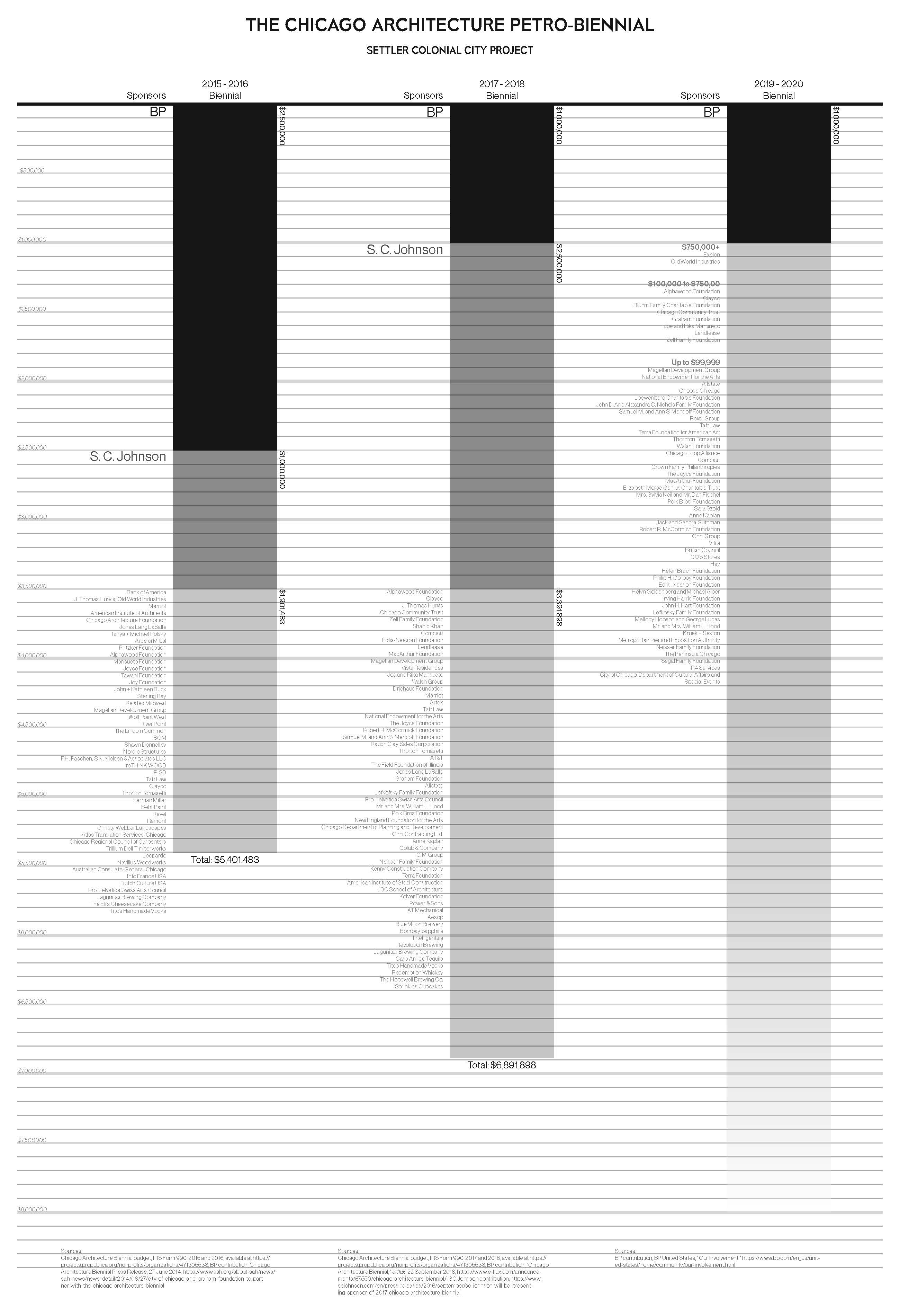The Petro-Biennial Complex
Petro-Colonialism, Petro-Capitalism, Petro-Philanthropy, Petro-Culture, and Indigenous Resistance and Futurity
 THE PETRO BIENNIAL COMPLEX
THE PETRO BIENNIAL COMPLEX
SCCP 2019
Oil money is not distributed based on where the arts are most in need, but on where the interests of the corporations can best be served.
BP Or Not BP? “Do the arts need oil sponsorship?”
BP’s sponsorship of the Chicago Architecture Biennial and other artistic and architectural programming is part of a deliberate corporate strategy. This strategy deploys cultural sponsorship to counteract BP’s public status as a protagonist in global warming, environmental devastation, and ongoing violence against Indigenous peoples and lands across the planet. This strategy also leverages the vast fiscal discrepancy between petro-capitalism and petro-philanthropy; BP’s initial $2.5 million contribution to the Chicago Architecture Biennial at once represented almost 50% of the biennial’s budget and 0.00001% of the company’s annual revenue.
In the words of Ian Conn, BP’s Chief Executive for Refining and Marketing, BP’s sponsorships aim at “brand protection and connection with customers and society,” along with the enhancement of the company’s “relationship with strategic commercial partners.”1 These ambitions are increasingly necessary for BP as the necessity to move away from oil towards carbon neutrality becomes ever more urgent. The Chicago Architecture Biennial, as the largest and most prestigious architecture biennial in the United States, thereby offers an ideal platform for BP to pose itself as a contributor to architecture and culture and displace recognition of BP as a contributor to impending planetary ecocide—the destruction of environments and the human and non-human life that supports and is supported by them.
BP is one of the planet’s central protagonists in climate crisis. Along with Chevron, Exxon, and Shell, BP is responsible for more than 10% of the world’s carbon emissions since 1965.2 While the prevention of climate catastrophe rests on keeping at least 80% of known fossil fuel reserves in the ground, BP continues to explore, extract, and profit from new fossil fuel sources.3 But BP does not only profit from continued fossil fuel use; as “Europe’s strongest advocate of dirty energy, opposing even mild measures to raise carbon trading prices,” BP also actively lobbies against policies that could mitigate climate crisis.4 And so, even as the necessity to transition from fossil fuels to renewable energy sources and carbon neutrality intensifies, BP continues to impede this transition and to bring planetary climate crisis and ecocide ever closer as unavoidable futures.
In “... And Other Such Stories,” at the 2019 Chicago Architecture Biennial, the curators have sought to reveal the forces that have shaped the planet, which they summarize in their curatorial statement as “colonial expansion, mass migration, extraction economies, and rapid industrialization.” The interest in climatic and ecological concerns expressed here stands in stark contrast with BP, its main sponsor. Furthermore, in the past, BP’s sponsorship of cultural institutions has not been neutral, pointing to additional complications in the horizon.5
Arguments on compromised funding range from absolute acceptance (with the justification that all wealth is compromised) to absolute refusal.6 Critics have pointed to the need to overturn larger systemic structures that lead to culture washing, rewarding corporations with tax breaks and favorable press in exchange for donations instead of taxing them and providing this income to cultural institutions as their due, rather than a favor.7 While institutional critique has provided a place for politics in the museum, the art object can easily be reabsorbed into the exhibitionary complex—a return that must be resisted at all costs if the politics of the object are to remain operative.8
The Settler Colonial City Project has decided to intervene both inside and outside the Chicago Architecture Biennial. We acknowledge that this is an imperfect solution but, in our view, it is preferable to inaction. Through the public discussion that is part of the biennial program, SCCP has embedded a critique of BP within the exhibition. Through this publication, which is not part of the biennial, SCCP actively resists appropriation by denouncing BP’s petro-colonialism and petro-philanthropy and by amplifying voices of Indigenous resistance speaking on behalf of decolonized futurities.
1 UK Tar Sands Network, “UK Tar Sands Network’s Questions to the 2012 BP AGM,” https://no-tar-sands.org/2012/04/16/uk-tar-sands-networks-questions-to-the-2012-bp-agm/.
2 Matthew Taylor and Jonathan Watts in “Revealed: the 20 firms behind a third of all carbon emissions, in The Guardian, 9 October 2019, https://www.theguardian.com/environment/2019/oct/09/revealed-20-firms-third-carbon-emissions.
3 Christophe McGlade, “The Geographical Distribution of Fossil Fuels Unused When Limiting Global Warming to 2 °C,” Nature 517 (2015).
4 Arthur Neslen “BP Tops the List of firms Obstructing Climate Action in Europe,” The Guardian, 21 September 2015.
5 On the influence of BP on institutions it sponsors, see “BP’s cultural sponsorship: A corrupting influence,” Art Not Oil Coalition, May 2016, http://www.artnotoil.org.uk/sites/default/files/BPs%20Corrupting%20Influence.pdf.pdf.
6 See Hannah Black, Ciarán Finlayson, and Tobi Haslett, “The Tear Gas Biennial,” in Artforum, 17 July 2019, https://www.artforum.com/slant/a-statement-from-hannah-black-ciaran-finlayson-and-tobi-haslett-on-warren-kanders-and-the-2019-whitney-biennial-80328.
7 See Hal Foster, “Change at MoMA,” London Review of Books, 7 November 2019, https://www.lrb.co.uk/v41/n21/hal-foster/change-at-moma.
8 See Aruna D’Souza on the Hans Haacke retrospective at the New Museum, D’Souza, “What can we learn from institutional critique?” Art in America, 29 October 2019, https://www.artinamericamagazine.com/news-features/magazines/hans-haacke-new-museum-retrospective-institutional-critique/.
Read and download this publication.